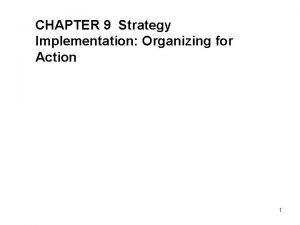Chapter 9 Negotiating Institutional Decision Making Decision Making














- Slides: 14

Chapter 9 Negotiating & Institutional Decision Making

Decision Making in Chinese Institutions n n Decisions are usually arrived at through a group process They use a leader-mediated compromise – meaning the leader listens to the opinions of many people then makes a decision that takes all opinions into account.

n n In short, Chinese group members typically have more input in the decision-making process than do American group members. Decision making requires much more time for Chinese decision-making groups than American decisionmaking groups.

n n n A basic fact of institutional life in China is that decision making in most institutions operates under the jurisdiction and authority of governmental leaders at some level. Because of the top-down structure of guidance and control emanating from the provincial capital or local seat of government, decisions of any consequence must be referred for approval up the hierarchical ladder. Hierarchical ladders in US too, but they are much shorter.

2 typical Frustrations of Americans who are working in or with Chinese institutions: n n 1) They cannot determine who makes the decisions about the issue or problem on which they need action. 2)That they cannot get decisions made within a time frame that they believe is reasonable.

The Cultural Bases of American and Chinese Decision Making n USA: culture emphasizes individual initiative and personal achievement, making things work and getting things done, efficiency and timeliness of action, and making the lives of individuals more comfortable and convenient.

n n An employee in U. S. institutional settings have as their objective moving up the status hierarchy. Higher status = greater wealth

Institutional Decision-Making Values in the People’s Republic n n n Chinese values stress the importance of the major primary groups to which each person belongs. American assumptions reflect equality of opportunity; Chinese assumptions focus on equality in the sharing of output. Conformity to group norms is viewed positively; distinguishing oneself from other group members in any way that disrupts the smooth flow of human relationships is criticized.

Five Differences Between Chinese and American Negotiating Practices n 1) Types of Institutions Represented: • Chinese will ultimately represent the interests and viewpoints of the government. • American negotiators are preoccupied with the profitability of their company.

2) Types of Relationships Envisioned n n Chinese institutional representatives expect that negotiation will lead to a partnership characterized by trust, obligations of mutual support, and permanence. It is more of an important social occasion and opportunity to foster a relationship. Americans are not averse to good social relationships but rarely see the building of permanent partnership as one of their principal goals.

3) Basic Approaches to Negotiating n The Chinese are not nearly as legalistic as are Americans and do not completely share the American view that a contract is a complete, binding, limiting set of specifications. • Americans tend to strive for an agreement through a contract, while Chinese institutions want to discuss mutual interests and general principles.

4)Perspectives on the Nature of Contracts n n Chinese negotiators usually arrive at the bargaining table either with no draft contract or with a rather simple on based on a standard pattern often used in China. American negotiators usually arrive with a long and complicated draft contract that is situation-specific and reflects the highly legalistic nature of business in the U. S.

5) Amounts of Time Required to Complete the Process n Reasons for the slow pace of Chinese negotiations and decision making: • The Chinese must fully discuss in detail all final decisions with colleagues • The two sides have differing views about the ultimate purpose of the document they are attempting to fashion. • The Chinese want to develop a partnership with a feeling of mutual trust and an aura of permanence.

The End
 Chapter 10 negotiating intersections
Chapter 10 negotiating intersections Chapter 7 negotiating intersections
Chapter 7 negotiating intersections Uncontrolled railroad crossings usually have ______.
Uncontrolled railroad crossings usually have ______. Chapter 7 negotiating intersections
Chapter 7 negotiating intersections Chapter 7 negotiating intersections
Chapter 7 negotiating intersections Objectives of decision making
Objectives of decision making Financial decision
Financial decision Slide 6/21
Slide 6/21 Negotiate sap license agreement
Negotiate sap license agreement Weiss strategic framework
Weiss strategic framework Pooled negotiating power
Pooled negotiating power Pooled negotiating power
Pooled negotiating power Chapter 6 prices and decision making assessment answers
Chapter 6 prices and decision making assessment answers Five step decision making process
Five step decision making process Chapter 2 economic systems and decision making answer key
Chapter 2 economic systems and decision making answer key



























